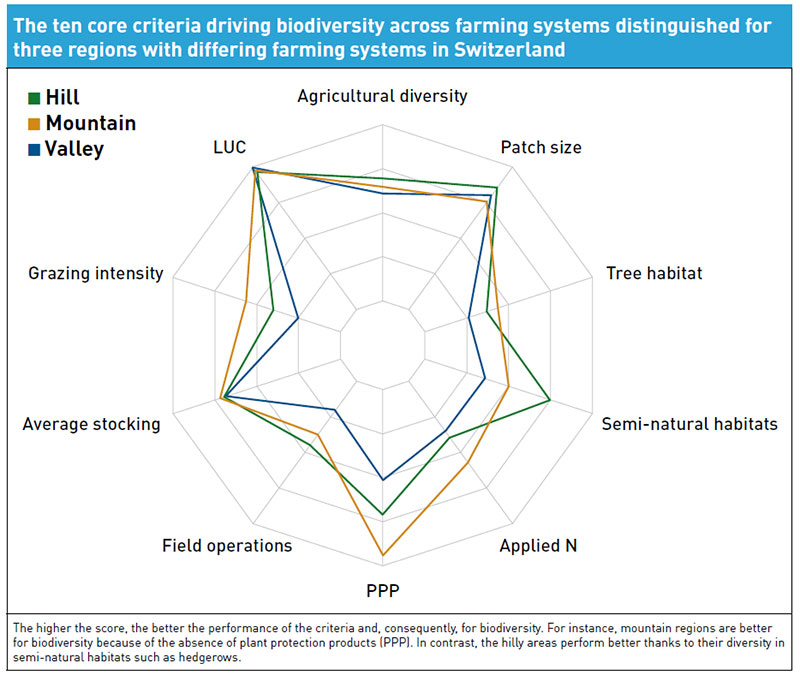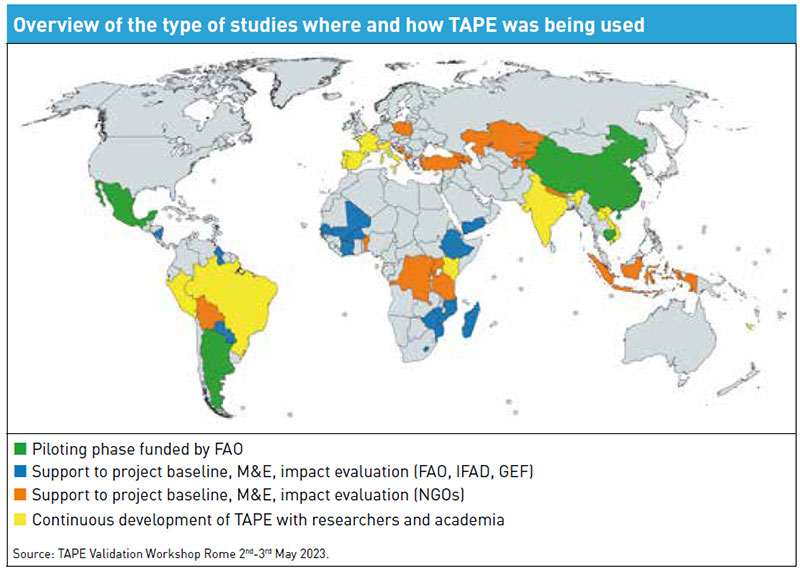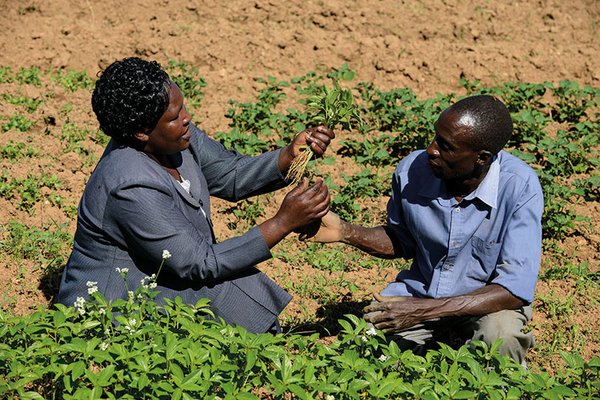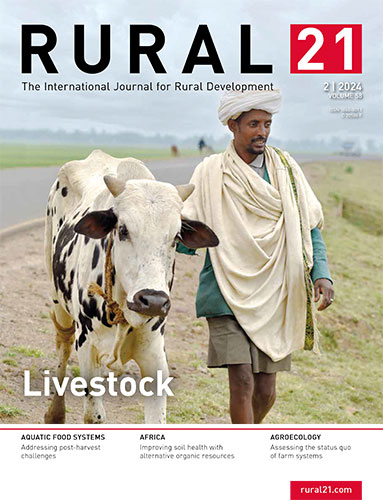 Download this article in magazine layout
Download this article in magazine layout
- Share this article
- Subscribe to our newsletter
Towards agroecological food systems transformation – experience with TAPE
In order to ensure food security and nutrition world-wide, a fundamental transformation of the agricultural and food systems is necessary. Currently, our food systems, especially the most intensive ones, contribute to harming natural resources, including land and water. At the same time, many forms of food production around the world do have positive roles in ecosystems preservation and restoration. As an example, besides contributing to climate change via greenhouse gas emissions, agricultural production is tremendously harmed by climatic extremes and also critical in climate change mitigation via reduction of greenhouse gas emissions and carbon sequestration in soils and biomass. Less intensive agricultural systems, as predominantly found in low-and-middle income countries (LMICs) suffer from nutrient limitation and poor access to finance and markets despite being the backbone of the food supply for up to 85 per cent of the global population. Consequently, agricultural systems are far from functioning at their optimum across the five sustainability dimensions (environment, social and cultural, economic, health and nutrition, and governance), and agroecological transformation is envisioned as a contribution towards meeting the relevant Sustainable Development Goals, including the aspects of food security and nutrition, by 2030.
Assessing the agroecological status-quo of farm systems
In essence, agroecological transformation is the sustainable modification of existing agricultural systems by ensuring the protection of biodiversity and natural resources through the co-creation and sharing of knowledge and more widely ensuring the fulfilment of the ten elements of agroecology published by the UN Food and Agriculture Organization (FAO) in 2018. One could imagine that such a transformation would automatically imply a reduction of current agricultural production, since the drivers that helped to increase agricultural productivity in the first place led to the currently observed non-sustainability with subsequent negative consequences. Already since the early 21st century, available intensification practices such as the use of industrially produced mineral fertilisers and pesticides, intensified irrigation measures or the decoupling of crop and livestock production resulted in fewer opportunities for circular agricultural systems. Often the key criteria for assessing the performance of agricultural systems were yields – not even the quality of yield harvested – while nutrition as well as other impacts such as environmental or social externalities were being treated as consequences that have to be dealt with downstream. Thus, holistic assessments – encompassing economic, ecological and social dimensions of agricultural systems and the identification of policy barriers have been proposed as the most promising way forward. Still, in-depth data on the agroecological status-quo of farm systems across countries and also where these systems can or should improve remains lacking.
There are plenty of publications available that describe the theoretical approach of agroecological food system transformation and yet only very few studies have shown specific data on what this could look like. Here, the Tool for Agroecology Performance Evaluation (TAPE), launched in 2019, offers a good approach (see Box below). So far, TAPE has been piloted and applied in a wide range of projects across 54 countries and in more than 10,000 farms, allowing for some preliminary analysis and lessons learned.
Assessing agroecological transformation
The Tool for Agroecology Performance Evaluation (TAPE) has been designed in order to consolidate global evidence on how agroecology supports the transformation to more sustainable agricultural and food systems across five dimensions of sustainability: (i) environment, (ii) social and cultural, (iii) economic, (iv) health and nutrition, and (v) governance. It has been developed based on a mandate of 197 countries to FAO and was launched in 2019.TAPE focuses on deriving farm level data bases on household surveys with the opportunity for upscaling. Results are usable for multiple actors, including farmers, researchers, decisionmakers as well as project evaluators.
What TAPE studies have revealed so far
The studies available so far are mostly project specific and focus on individual countries or specific indicators, allowing a preliminary assessment of the potential of TAPE. For instance, in Mali, it was shown that more agroecological farms produce more and generate more income with less use of external resources. Moreover, agroecological farms use fewer pesticides, show better soil health, are higher in biodiversity, have access to local and territorial markets and bear clear advantages regarding youth empowerment. In Switzerland, a pilot of TAPE not only allowed modifying the Tool to be applicable in high income countries but enabled a comparison of strengths and weaknesses between regions. For instance, it has been shown that farms in the mountain regions are performing better than the valley farms in terms of biodiversity thanks to their absence of pesticide applications and lower stocking rates. At the same time, farming systems located in between the mountains and valley regions are more diverse in semi-natural habitats, such as hedgerows (see Figure below). However, the valley farms are more productive and economically more resilient due to diversification. In addition, applying TAPE in countries where multiple other data streams on agricultural performance are already available enables improvements in specific indicators within TAPE. In this individual case, Agroscope – the Swiss Federal Excellence Centre for agricultural research – developed an advanced biodiversity indicator for TAPE. The new indicator takes ten drivers of biodiversity into account and allows assessments of biodiversity across the farm boundaries and beyond current agrobiodiversity.

During a TAPE validation workshop at the Food and Agriculture Organization (FAO) in April 2023, first results from a dataset encompassing more than 3,000 farms in 40 countries were presented. The global dataset showed the widespread use of TAPE and enabled a distinction between the actual status of TAPE application and the purpose of its application in specific countries. This included pilot projects, support to baseline assessments of agroecological transformation for both donors and UN agencies and NGOs and projects that assist in developing the Tool further (see map).

The global dataset, containing all the individual project data that were shared with FAO, enabled the provision of some basic overview on how agricultural systems differ between continents, for instance how farming systems rely on livestock. Thereby livestock – even though controversially debated given its large environmental footprint and the concerns of animal welfare particularly in intensified and specialised farming systems – is part of the solution for agroecological transformation when integrated with crops and trees. Livestock is not only essential for supporting livelihoods in LMICs, it further contributes to a farms diversity – a key contributor to the Characterization of Agroecological Transition (CAET) score (see Box) – and promotes better circularity of nutrients within farming systems. Besides that, there are vast amounts of agricultural land that allow livestock keeping only – including the central Asian steppe ecosystems, the savannah systems in Africa or even the sub-alpine meadows in the Alps. In-depth analysis is currently being undertaken for individual projects, and foreseeable results will enable an identification of specific entry points for agroecological transformation at farm level.
The Characterization of Agroecological Transition (CAET) score aims at characterising the degree of transition to agroecology of agricultural systems. The ten elements are used as a criteria to define semi-quantitative indices that take the form of descriptive scales with scores from 0 to 4. Each element is described with three or four indices, resulting in a total 36 indices which are used to calculate CAET.
What is next?
Agroecological transformation is key to a sustainable agricultural and food system. TAPE results currently provide a snapshot and thus baseline information on farm systems in individual regions at project level. We identified a minimum of five areas for further improvement of TAPE, which need to be considered to unleash the full potential of the tool. This became particularly obvious during the pilot phase, when the tool was used for many more purposes than initially planned, including project design or project evaluation.
First of all, TAPE should be used ex-ante, such as in project design, aiming at assessing agroecological transformation, and not only ex-post analysis. This way it is possible to reliably assess the impact of individual interventions and provide the necessary robust evidence for decision-makers in the future.
Secondly, a TAPE survey should be carried out at regular intervals – not necessarily just once during the project duration, but each year or each second year if possible. Through such an approach, the agroecological transformation can be traced over time. Barriers for repeated surveys are small, especially since updating an existing questionnaire only needs limited efforts compared to establishing a baseline
Thirdly, agroecological projects should aim at going beyond the farm scale and include consumers and retailers to cover the full agricultural and food systems. Consequently, this also means that TAPE may be further developed to capture consumer behaviour.
The fourth area of improvement includes the development of new additional indicators – such as a potential climate score to include climate change mitigation co-benefits or trade-offs of agroecological transformation at farm level. It needs to be noted that the validation of existing indicators is also part of the future development for TAPE.
A fifth, and likely the most challenging development of TAPE, is its applicability at national scale. Besides an example from Brazil, where basic census data was used to perform Step 1 of TAPE, most projects so far focus on specific regions or were part of specific projects which does not necessarily allow drawing conclusions at national scale.
Many of these areas for future development are already being tackled and highlight the usability and support of the tool globally. Each of these five areas of improvement requires standardisation with regard to data collection by a variety of enumerators and in-depth data quality and data assurance steps. Only if these steps are thoroughly implemented can reliable and robust analysis across projects, regions and countries become possible. Partnerships are key to achieving these objectives, and the continuous involvement of farmers’ organisations, NGOs, development agencies and academia in the tool development and deployment is crucial. For instance, the pilot testing of a digital platform in the context of the CIFOR-ICRAF-led MAP (Measuring agroecology performance) project to tailor the tools to users’ individual needs and provide better support to users (from data collection to data visualisation or data access) and the forming of a Community of Practice of TAPE – under the Transformative Partnership Platform on Agroecology (TPP Agroecology) – is a promising step towards such future applications. This movement, which is currently growing, will be one useful element in driving the agroecological transformation of our food system forward.
In parallel to TAPE, various other initiatives aim at assessing agroecological transformation. Examples include the European Partnership “Accelerating Farming Systems Transition: Agroecology Living Labs and Research Infrastructures”, which is an ambitious, large-scale European research and innovation endeavour launched earlier in 2024. Another initiative is the Agroecology Coalition, which aims at facilitating co-creation and exchange of knowledge, promoting increased investments in agroecology and seeking political engagement and increased commitment to the agroecological transformation. In addition, there are many national initiatives focusing on agroecological transformation. A third example is the Transformative Partnership Platform on Agroecology (TPP Agroecology). Still, a global assessment using a similar approach is lacking. The diversity of approaches and tools contributes to enhancing our knowledge of agroecological assessment. Consolidating and harmonising these findings has become critical, and the effort of the global community built on TAPE can help.
Lutz Merbold is head of the strategic research division agroecology and environment at the Swiss Federal Excellence Centre for Agricultural Research – Agroscope based in Zurich, Switzerland.
Rémi Cluset is advisor on agroecology of the director of the NSP (Plant Production and Protection Division) in the Food and Agriculture Organization (FAO) in Rome, Italy.
Anne Mottet is Lead Global Technical Specialist (Livestock) at the International Fund for Agricultural Development (IFAD) in Rome.
Contact: lutz.merbold@agroscope.admin.ch
More information:
European Commission: Partnership on agroecology
(Partnership on agroecology - European Commission (europa.eu))
Website Agroecology Coalition
(Home - Agroecology Coalition (agroecology-coalition.org))





Add a comment
Be the First to Comment